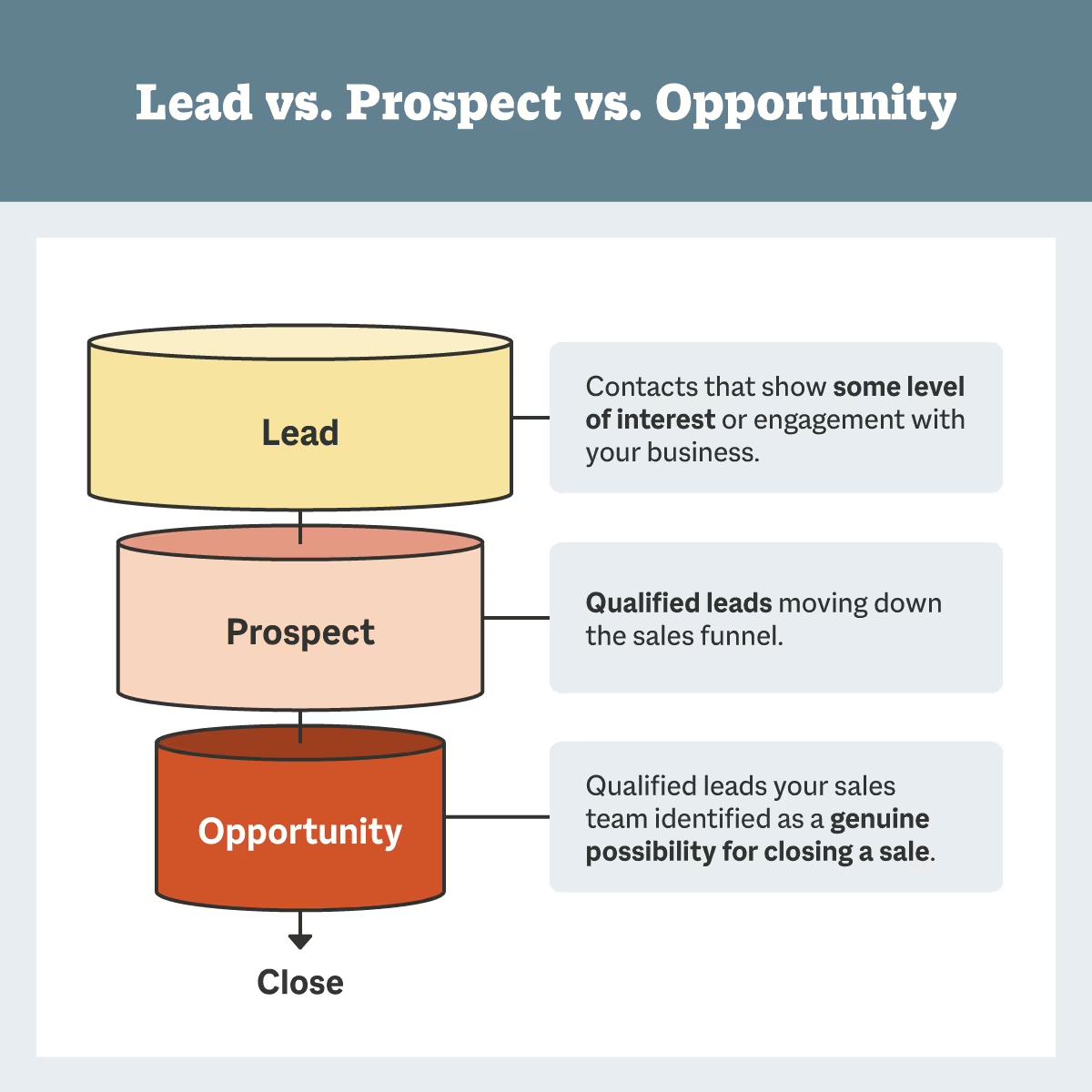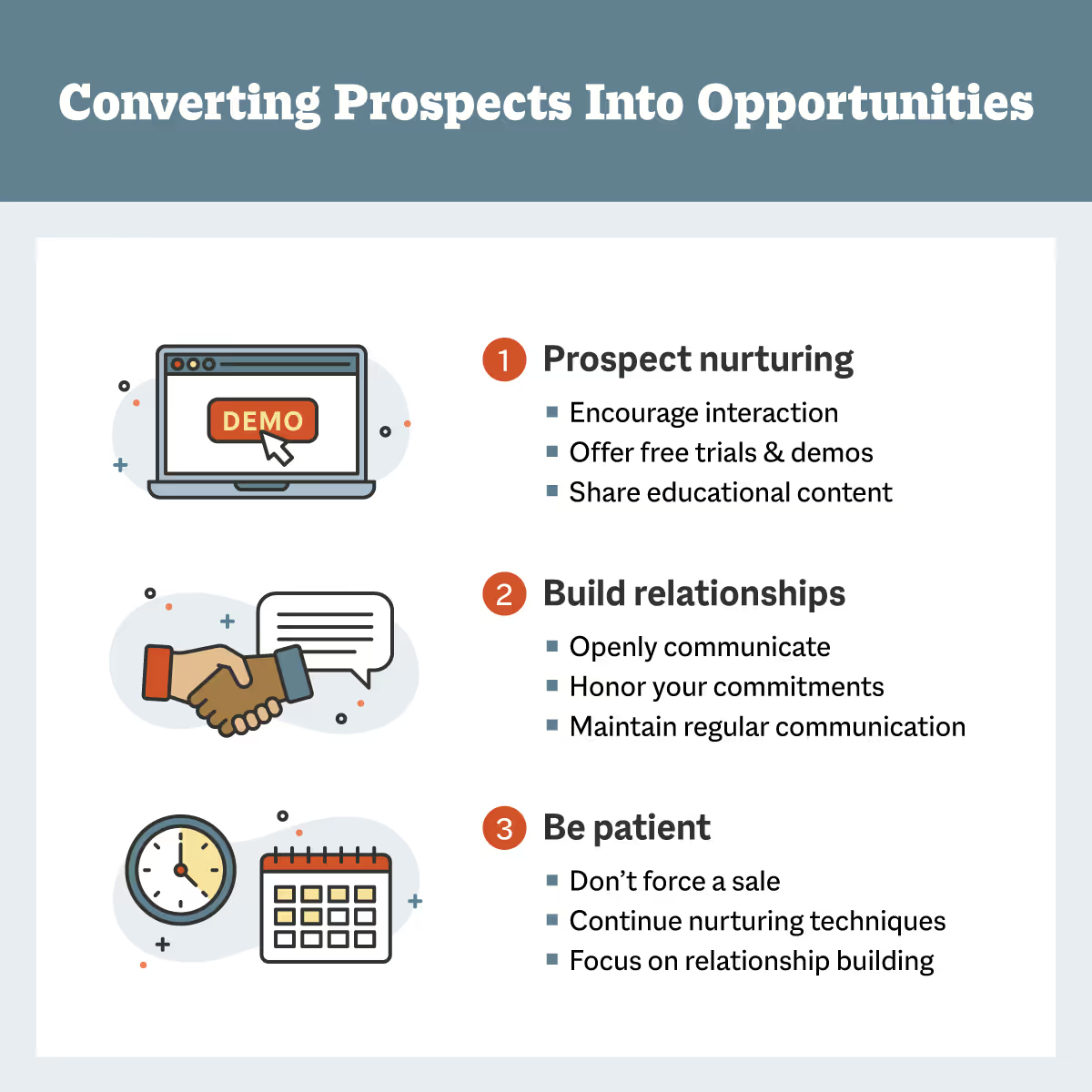Lead vs. Prospect: How To Convert Them to Opportunities
Lead vs. Prospect: How To Convert Them to Opportunities

Sales professionals frequently use the terms "lead" and "prospect" interchangeably, creating confusion about their actual distinctions. While they share similarities, their meanings can vary depending on the context.
To address this confusion and aid in your sales efforts, we prepared a guide that clarifies the disparities between a lead vs. prospect. Furthermore, we’ll walk through techniques to help you effectively convert these potential customers and clients into opportunities, culminating in successful sales. Let’s get started!

What is a lead?
A lead is a general term that refers to a potential customer or organization that shows some level of interest or engagement with your business.
You'll typically find leads at the very top, or the initial stage of your sales funnel, meaning they’ll need further qualification and nurturing to determine their potential as a paying customer.
Types of leads
There are several types of leads, categorized based on various factors. Note that the types of leads can vary based on your specific industry, business, and sales process. People you may consider leads are those who:
- Engaged with your website (blog visits, product page views/clicks, etc)
- Actively engage with your social media (likes, comments, follows, and shares)
- Signed up for your email newsletter
The leads at the very top of the funnel are typically referred to as Marketing Qualified Leads (MQLs), which are leads your marketing team has identified as showing interest in your offerings through marketing efforts.
What is a prospect?
A prospect is a more qualified lead that you assessed to have a higher likelihood of becoming a paying customer. A prospect is also known as a warm lead or a Sales Qualified Lead (SQL).
Unlike a lead, a prospect has undergone some level of evaluation or qualification to determine if they meet certain criteria that make them a good fit for the products or services you offer.
This qualification may involve factors such as budget, need, authority, and timeline (commonly known as BANT criteria). Prospects are typically further along in the sales pipeline and considered more likely to convert into customers.
Types of prospects
Prospects are essentially leads that have been qualified in some capacity and shown interest in your offerings but haven’t yet reached the stage of being fully ready for a sale. Here are some examples of what a prospect may look like:
- Someone who visited your booth at a trade show and engaged in a conversation about your offerings
- A person who attended a webinar or a workshop organized by your company and expressed interest afterward
- A referral from an existing customer who recommends your product or service to their colleague or friend
What is a sales opportunity?
A sales opportunity is a thoroughly qualified lead or prospect that your sales team identified as a genuine possibility of closing a sale. Some organizations will refer to these leads and prospects as Sales Accepted Leads (SALs).
Their progression to the bottom of the sales pipeline indicates their potential to become a paying customer is high.
Your sales team must proactively engage in nurturing and closing the sales opportunity, with the ultimate goal of successfully converting it into a sale.
Types of opportunities
Opportunities are highly qualified people interested in your offering and are ready to move forward with the sales process. Here are some examples of sales opportunities:
- A business executive who has expressed interest in a specific product and has the authority to make purchasing decisions
- A person who has reached out with specific questions about your service and has a budget allocated for it
- Someone who has requested a sales call or a meeting from a web form to discuss their requirements in more detail

How to convert a lead into a prospect
Converting a lead into a prospect involves nurturing and engaging with the lead to further qualify them and increase their likelihood of becoming a paying customer. Here are some effective ways to convert a lead into a prospect.
Start lead qualification
Since prospects are leads that underwent a qualification process, the first step is to evaluate your leads to determine whether or not they’d be suitable for your offerings.
To qualify a lead, you’ll need to reference your ideal customer profile (ICP) which is essentially a detailed description of the characteristics and attributes that define the most suitable and desirable customers for your business.
With your ICP in place, you can then build various buyer personas which are fictional representations of your ideal customer based on research and data about your target audience.
From there, you should gather leads that fit into your buyer personas. Once you establish a fit, follow these simple steps to begin qualifying them:
- Research or engage your lead to gather basic information about their needs, challenges, and goals.
- Determine if the lead has a budget allocated for the product or service you offer. Understanding their financial capacity is crucial to ensure a potential match.
- Identify if the lead has the authority to make purchasing decisions. It’s important to engage with decision-makers or those who have significant influence in the decision-making process.
- Determine the lead's timeline for making a decision or implementing a solution. Assess if their timeline aligns with your sales cycle and if they have a sense of urgency or a specific timeframe for procurement.
You can typically gather this information through online forms, quizzes, or downloads that require an email address. Some lead generation tools can even give you insights into data that reveals this type of information, helping streamline the process.
You may even be able to secure a discovery call with a lead which will give your sales team the ability to ask these qualifying questions during their meeting.
Begin lead nurturing
If you discover your lead is qualified, begin the lead nurturing process to help them move down the sales funnel. Lead nurturing is a process that aims to build a relationship with potential customers and guide them through the buyer's journey, ultimately converting them into prospects or qualified sales opportunities.
Here are some key steps to effectively nurture leads and turn them into prospects:
- Categorize your leads into different segments based on their characteristics, behavior, or interests. This allows you to create targeted nurturing campaigns that deliver the right content to the right people at the right time.
- Create a series of personalized and automated touchpoints that provide value to your leads. This can include educational content, industry insights, case studies, webinars, or product demonstrations. Focus on addressing their pain points and educating them about your offerings.
- Tailor your messages and content to the specific needs and interests of each lead segment. Use their names, reference their previous interactions, and provide recommendations based on their preferences. Personalization helps build trust and engagement.
- Implement a lead scoring system to track and evaluate lead engagement, behavior, and readiness to purchase. Assign scores based on actions taken, such as opening emails, visiting specific webpages, or downloading resources. This allows you to identify highly engaged leads and prioritize them as prospects for further sales outreach. By scoring your leads, your sales team can focus their time on the ones that have the most points, i.e. the ones most ready to buy, to improve the chances of closing more deals.
Follow up regularly
Consistently following up with a lead is crucial to staying top of mind. Use a combination of email, phone calls, and social media interactions to maintain communication and provide updates on relevant offerings, promotions, or testimonials.
Persistence and responsiveness demonstrate your commitment and can help move the lead closer to becoming a prospect.

How to convert a prospect into a sales opportunity
To turn prospects into sales opportunities and increase the likelihood of closing a sale, consider implementing the following strategies.
Continue with prospect nurturing
Prospect nurturing is essentially lead nurturing that focuses on strategies better suited for those that are further in their buyer's journey. This is where you should begin developing a deeper understanding of your prospect and build a personal connection with them.
Here are some essential nurturing techniques to help your prospects turn into sales opportunities:
- Encourage interaction and dialogue with your prospects. Ask questions, seek their opinions, and listen actively to their responses. This fosters a sense of partnership and demonstrates that you value their input, building trust and rapport.
- Be responsive to prospect inquiries and requests. Promptly address their questions or concerns and follow up on any commitments you make. Consistency and reliability in your communication show professionalism and dedication.
- Offer product demonstrations or trials so your prospects can experience your product or service firsthand. This can be through product demonstrations, free trials, or samples. Hands-on experience can significantly increase their interest and help them understand your value.
- Share educational and informative content that addresses the prospect's pain points and offers valuable insights. This can include industry reports, case studies, whitepapers, blog articles, or webinars. Position yourself as a trusted advisor who understands their challenges and can provide solutions.
Build deeper relationships
Focus on building a relationship with the prospect based on trust, understanding, and open communication. Take the time to understand their unique needs, challenges, and goals. This allows you to tailor your approach and demonstrate your genuine care about their success.
Here are some quick tips to help build a better relationship with your prospects:
- Encourage open dialogue and actively listen to them. Ask thoughtful questions to understand their perspectives and actively engage in meaningful conversations. This demonstrates that you value their input and opinions.
- Honor any commitments you make to your prospects. Whether it's providing additional information, scheduling a meeting, or delivering a proposal, ensure that you follow through in a timely manner. Reliability and accountability strengthen the trust and credibility of your relationship.
- Maintain regular communication through relevant touchpoints such as newsletters, industry updates, or personalized emails. Share valuable content that keeps your brand top of mind and reinforces your expertise in their field.
Be patient
The majority of prospects in your sales pipeline are likely categorized as "not yet ready to buy." However, it's important to maintain patience in this situation.
By committing to the nurturing process and consistently building relationships with your prospects, you will increase the chances of them becoming future customers. What's even better is that these customers will likely remain loyal to your company in the long run, as you have invested significant effort in understanding their needs.
While it's crucial to focus on closing deals in the present, it's equally important not to overlook the potential deals that will arise in the future—whether that be tomorrow, next month, or even next year.
Smith.ai can help you find and convert your leads
Clearly understanding the distinction between a lead vs. prospect empowers you to use targeted techniques that can progress them towards a sale.
With Smith.ai, businesses can leverage the expertise of our agents who specialize in inbound call answering as well as outreach campaigns. Our 24/7 live agents will qualify and nurture your leads for you, ensuring a streamlined and efficient process that ultimately results in more opportunities and increased sales.
If you want to learn more about how Smith.ai can help your business, book a free consultation.
Take the faster path to growth. Get Smith.ai today.
Key Areas to Explore
Technical Implementation Terms
Voice user interface (VUl) design
Speech recognition integration
Text-to-speech optimization
API connectivity and webhooks
Real-time data synchronization

Your submission has been received!













.svg)



